As reported in our previous research updates, we are investigating the top-scoring genes with associations to various cancers as part of the Mapping Cancer Markers (MCM) project. This article focuses on Ecdysoneless Cell Cycle Regulator (ECD), a gene that is involved in regulating growth and repair.
Terminology
- Transcription: the process by which DNA is “copied” to create an intermediate molecule called RNA, which is further translated to create proteins. The process of transcription enables the instructions encoded in DNA to be used to build functional proteins in the cell.
- Transcriptional co-activator: a protein that works with other protein partner(s) to “turn on” the expression of a certain gene and activate transcription.
- Proliferation: the process by which cells grow and divide, which is essential for cell maintenance, but can lead to cancer if uncontrolled.
- Cell cycle: the series of tightly regulated steps that a cell goes through to replicate. This includes interphase (G1, S, and G2 phases), which is cell growth and DNA replication, followed by the nuclear and cell divisions (M phase).
- p53: a protein that protects against cancerous growth and excess proliferation, but is often mutated or absent in many cancers.
- E2F: a protein that is essential for “turning on” genes that permit progression through the cell cycle.
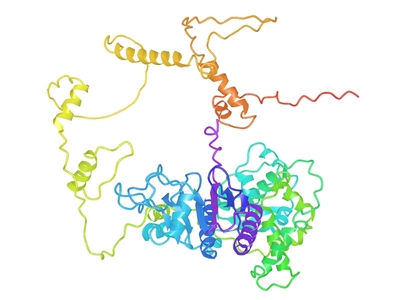
Background
The MCM project harnesses the power of large-scale computational analysis to improve our understanding of cancer and how to treat it. By investigating millions of signatures from healthy and cancerous tissue, we are systematically identifying the key drivers of cancer from the bottom up. This project is empowered by the contributions of our volunteers, whose computational power enables the identification of important genes driving lung cancer progression and treatment response. As of July 2025, MCM volunteers have generated over 2.7 billion results towards helping us identify the genetic markers driving cancer risk and severity. We greatly appreciate your continued support!
The MCM project has led to the discovery of 26 high-scoring genes that are linked to lung cancer development. We investigated PDE8B in our May 2025 research update, and the next gene we are focusing on is ECD.
ECD, the protein product of the ECD gene, carries multiple roles in the cell, making it a crucial player in both healthy and cancerous states. Its key functions are summarized below.
Transcription Co-Activation
ECD can function as a transcriptional co-activator. This means that ECD works alongside other proteins in the nucleus to “turn on” genes in a process called transcription, where genetic information is copied from DNA to get the instructions to make proteins that carry out various functions in the body. ECD’s key protein partner is p300, which regulates the transcription of many genes, including those involved in cell proliferation. While proliferation is a normal part of growth and healing, it can lead to cancer when uncontrolled. Since ECD helps to regulate this process, this reaffirms its role in cancer development [PMID:19919181,PMID:23307074].

Cell Cycle Progression
Beyond its roles in gene transcription, ECD also directly influences cell proliferation. This process is governed by the cell cycle, a series of tightly regulated steps that ensure cell division at the right time.
A driver of the cell cycle is a protein called E2F, which activates genes needed to complete division. Typically, E2F is regulated by another protein called Rb, which ensures that cell replication only occurs when it is needed. ECD can directly bind to Rb to free E2F, enabling E2F-mediated cell cycle progression to proceed.
If ECD is overly active, control of the cell cycle could be lost, potentially leading to unchecked cell replication and increased cancer risk. However, loss of ECD can also be harmful. Without enough ECD, E2F activity may be too limited, which can interfere with normal cell division needed for important processes like cell repair. As such, ECD activity must be carefully regulated to maintain proper cell cycle control [PMID:19640839].
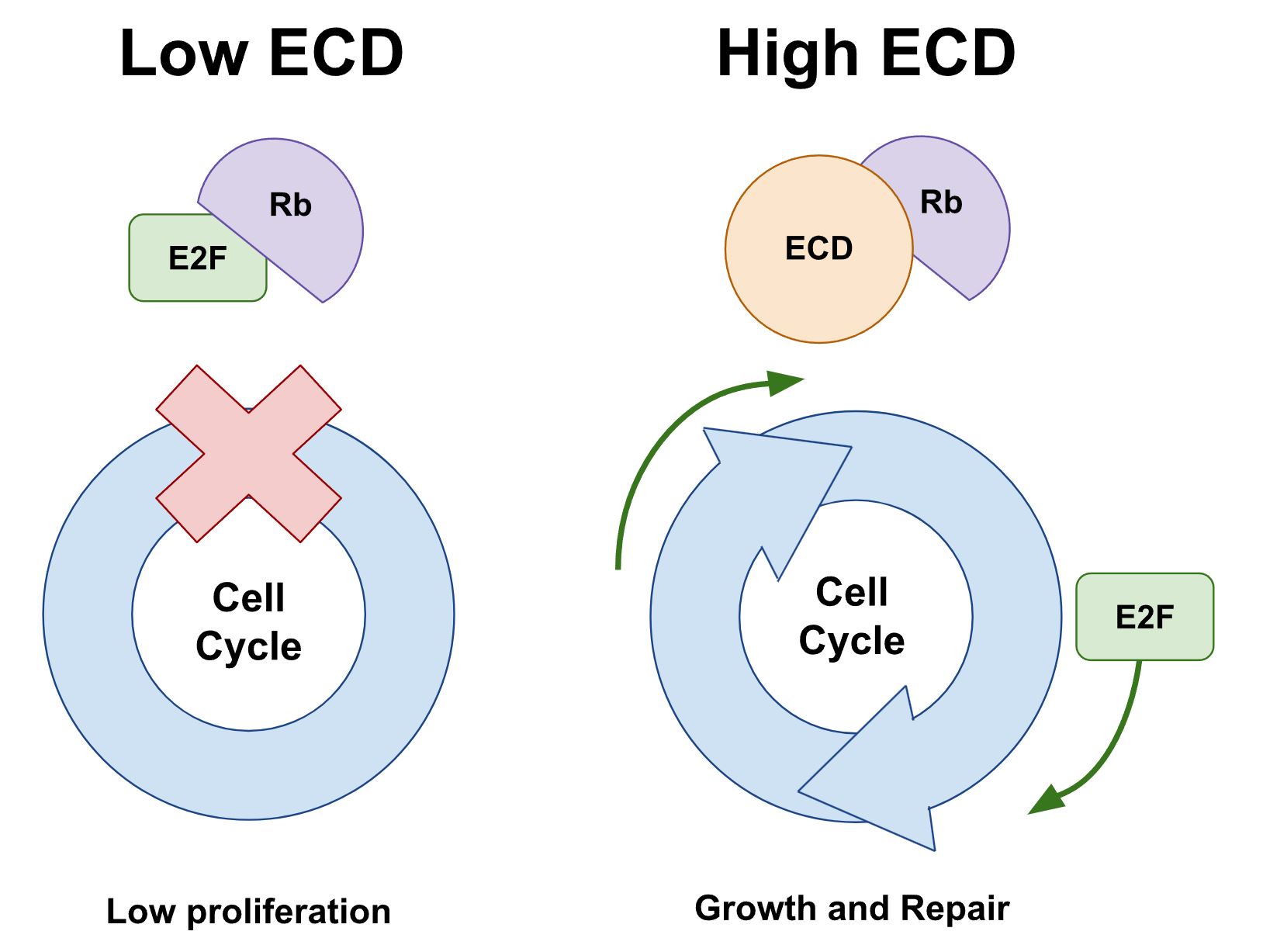
Tumor Suppressor Regulation
Paradoxical to its role in pro-growth signalling, ECD also moderates anti-growth processes in certain contexts. For example, ECD is a positive regulator of p53, one of the most crucial proteins in tumor suppression. Under non-cancerous conditions, p53 is degraded by the MDM2 protein, which keeps p53 levels low. ECD can bind to MDM2 and prevent it from degrading p53; thus, increasing p53 activity and promoting p53-mediated repair and cell cycle arrest [PMID:16849563].
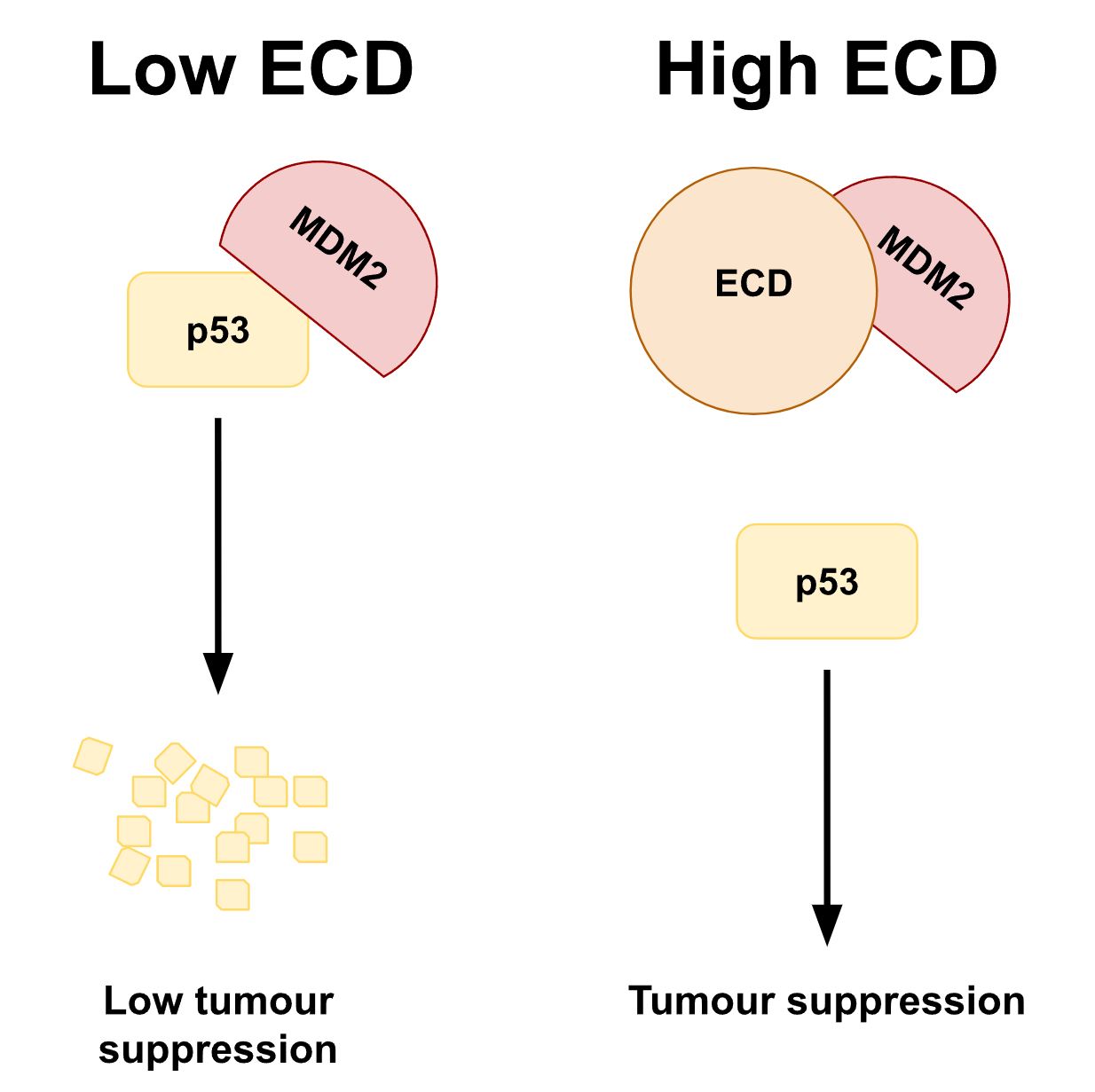
Reconciling the Anti- and Pro-Proliferative Roles of ECD
As described above, ECD can promote cell proliferation by interacting with p300 and Rb. However, ECD can also protect against cancer by supporting p53 signalling, a tumor suppressive pathway that prevents damaged cells from dividing. These seemingly opposite roles can be better understood by examining the broader picture of how cancer develops. In many cancers, p53 is inactivated or mutated, meaning that ECD’s p53-stabilizing role is irrelevant. Therefore, in that context, ECD’s pro-proliferative role becomes more dominant, and is more likely to promote cancer progression [PMID:36400749].
Expression of ECD
ECD can be found in almost every organ in the body, with particularly high levels in the digestive system (Figure 5). Coinciding with its presence in various tissues, ECD expression has been detected in multiple cancers, such as colorectal, breast, testicular, and lung cancer (Figure 6). As expected from its paradoxical roles in proliferative and anti-proliferative processes, ECD has been linked to both beneficial and unfavourable outcomes in various cancers. For example, high ECD expression is associated with improved survival in glioblastoma multiforme, a type of brain cancer. Conversely, ECD expression is linked to poorer outcomes in renal chromophobe, a kidney cancer (also called renal cell carcinoma). As such, it is crucial to consider the tissue-specific and patient-specific context when evaluating the role of ECD in cancer.
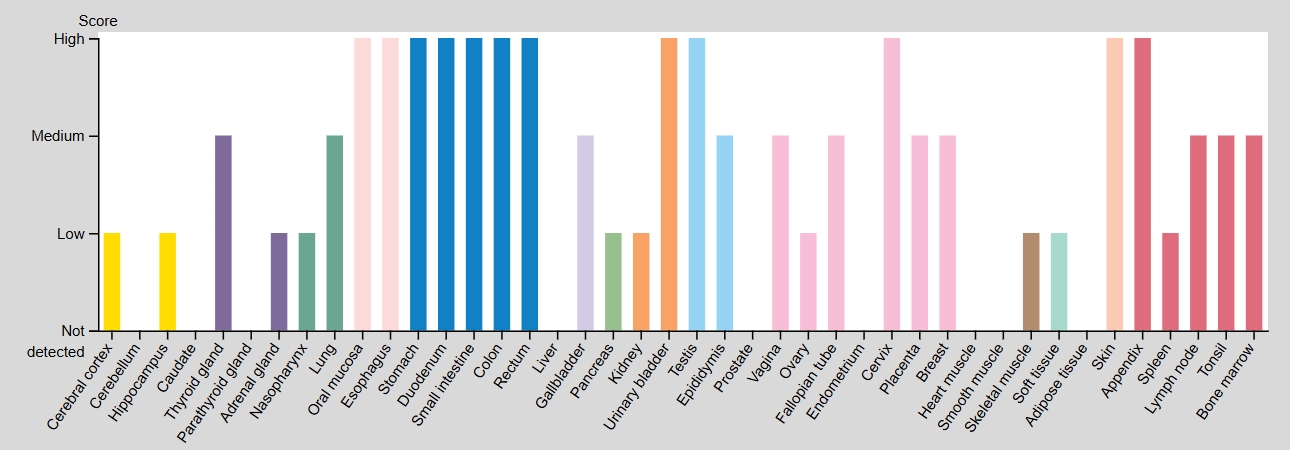
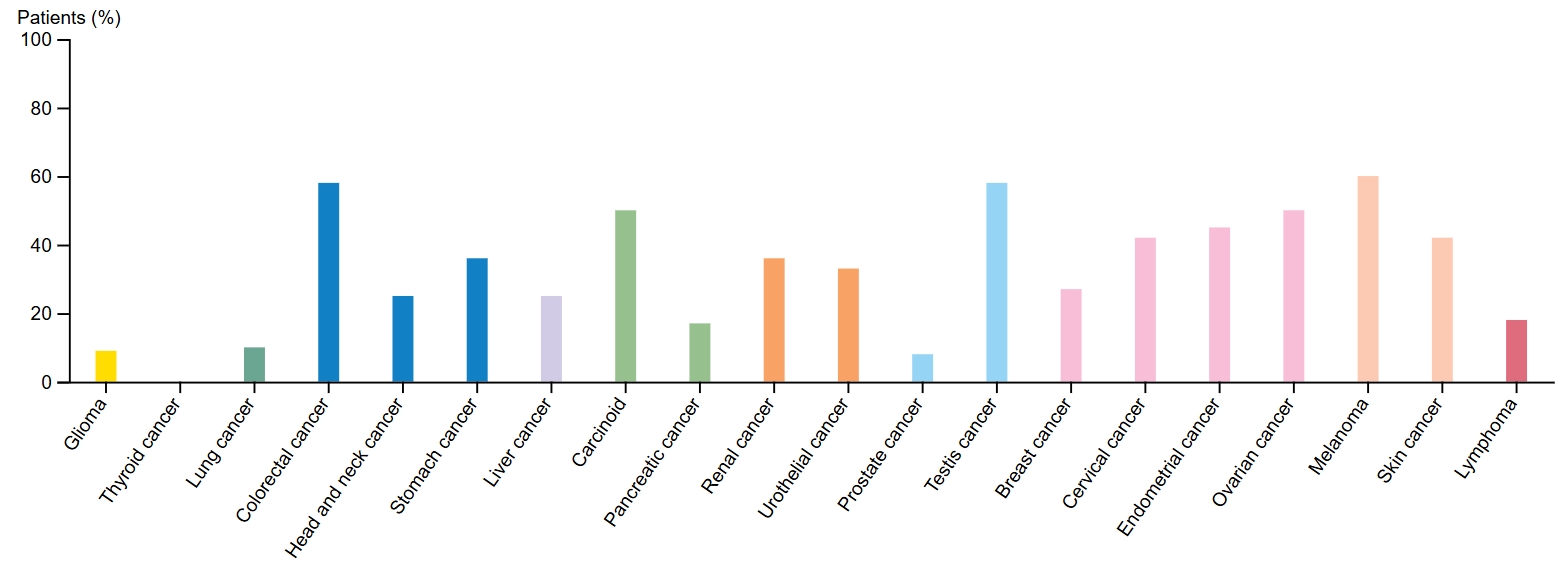
ECD in Lung Cancer
Most research on ECD to date has been in the context of other cancers, such as breast, gastric, and cervical cancers, and its role in lung cancer remains largely unexplored. However, data on patient outcomes suggest that patients with lung adenocarcinoma (ADC) and low ECD expression have a greater likelihood of survival (Figure 7A). However, in another lung cancer type called squamous cell carcinoma (SQC), ECD levels don’t appear to influence survival (Figure 7B).
In our previous research update, we found that differences in survival rates in ADC based on PDE8B expression were related to smoking status. Specifically, only ADC patients with a smoking history had improved survival rates with high PDE8B expression. For ECD, both smokers and non-smokers with ADC had improved survival with low ECD expression (Figure 8). Notably, non-smokers appear to benefit more strongly from low ECD expression (HR: 2.29 for non-smokers, versus 1.36 for smokers). However, considering the short follow-up time for the study, there may be other factors influencing these results, such as age, sex, and the presence of other co-morbidities (e.g. obesity).
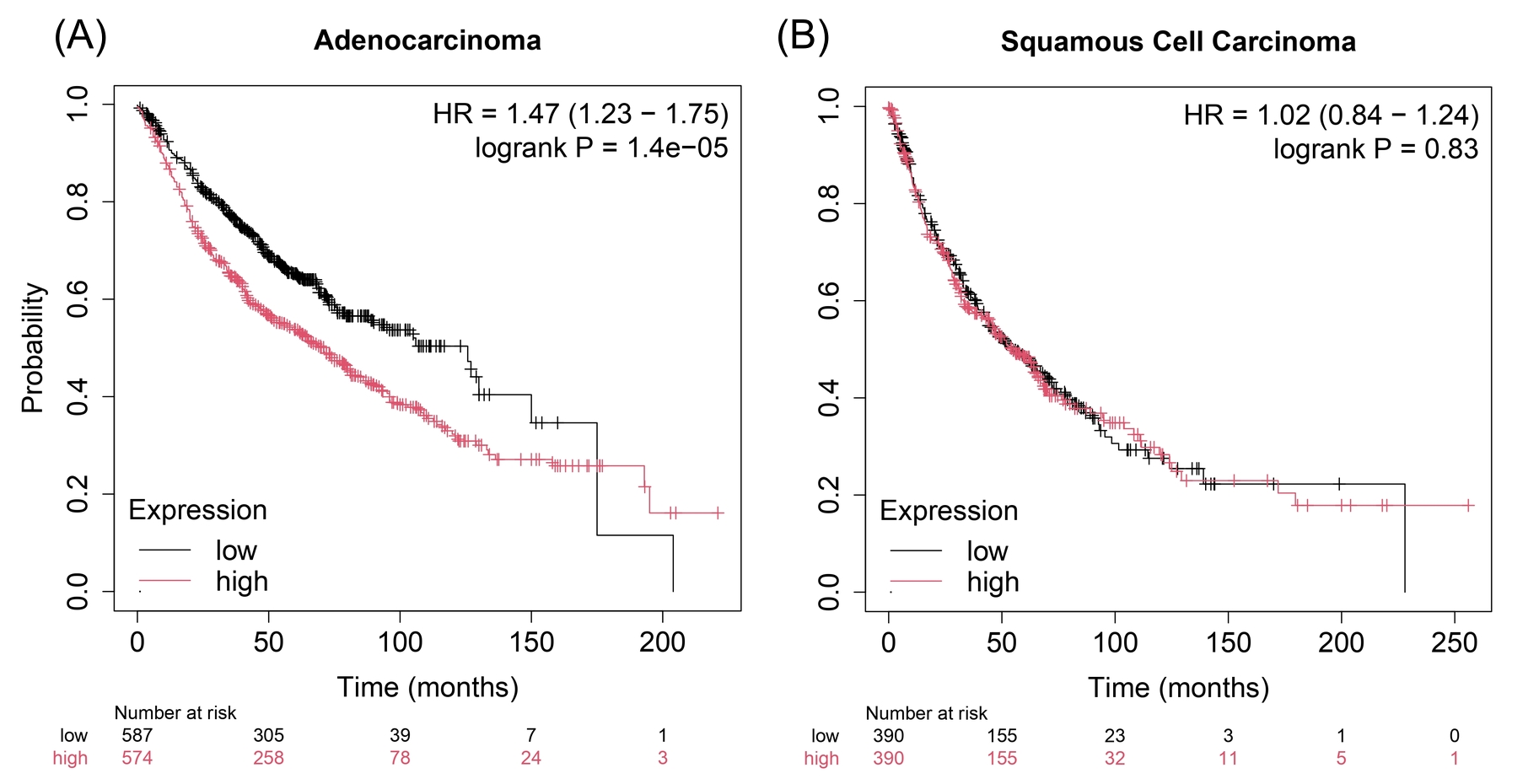
Figure 7. Kaplan-Meier survival curve for lung adenocarcinoma (ADC) (A) and lung squamous cell carcinoma (SQC) (B). This graph describes the probability of survival (y axis) over time (x axis). (A) Low expression of ECD (black curve) is associated with a greater probability of survival, compared to low expression of ECD (red curve), in lung ADC. Specifically, low expression of ECD, compared to high expression of ECD, is associated with a greater chance of survival (HR = 1.47 (1.23-1.75), p = 1.4 ✕ 10-5). (B) Low expression of ECD is not associated with a greater probability of survival, compared to high expression of ECD, in SQC (HR = 1.02 (0.84-1.24), p = 0.83)). Figures generated using KM Plotter.
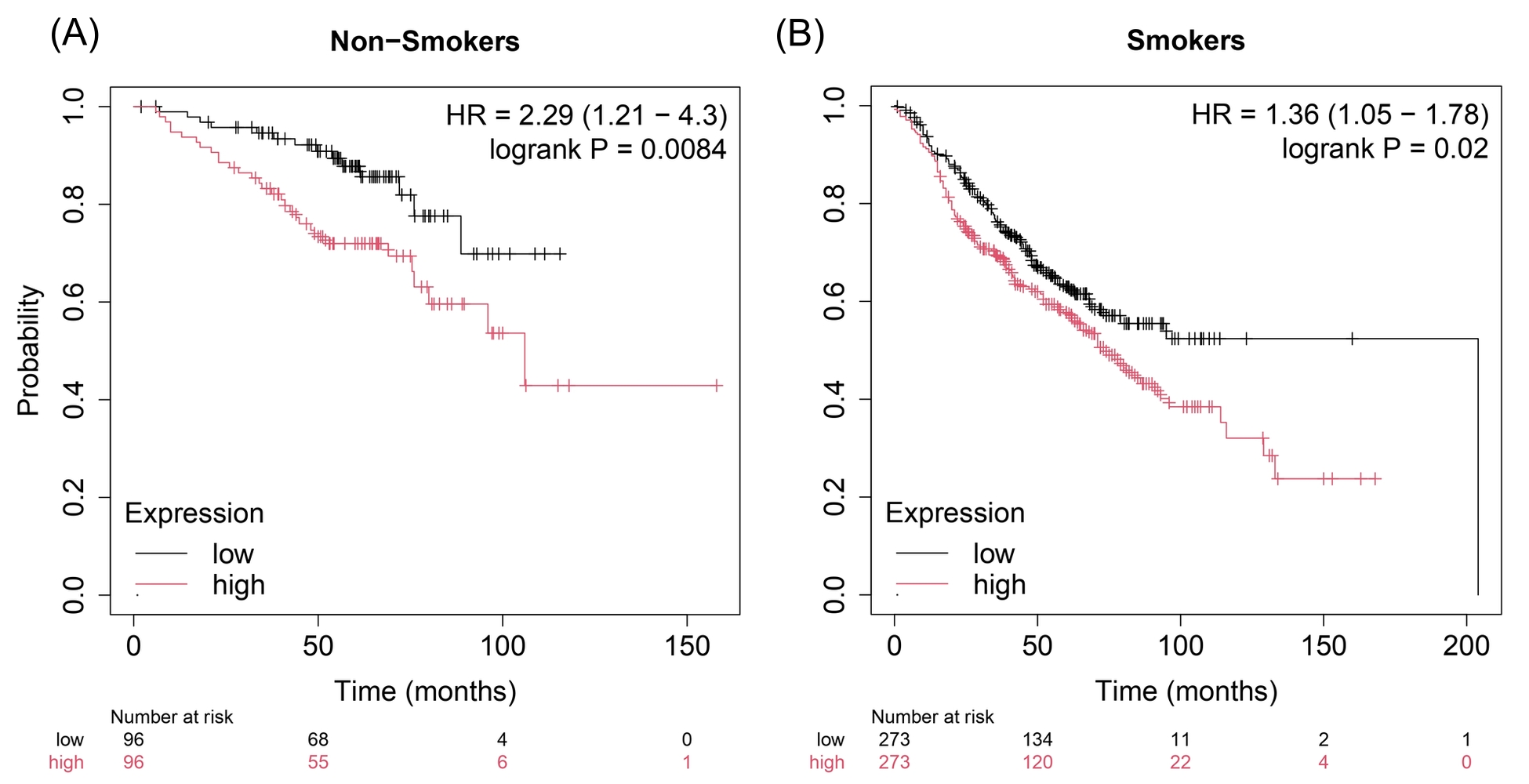
Figure 8. Kaplan-Meier survival curve for adenocarcinoma (ADC), in patients with smoking history (A) and in patients who have never smoked (B). Low expression of ECD (black curve) is associated with a greater chance of survival in patients with smoking history (HR = 1.36 (1.05-1.78), p = 0.02) and with no smoking history (HR = 2.29 (1.21-4.3), p = 0.0084). Figures generated using KM Plotter.
Although ECD is not well characterized in lung cancer yet, it has been linked to outcomes in cervical, breast, and gastric cancers (Figure 9).
- In cervical cancer, “knocking down” ECD decreases cancerous growth patterns in cell-based models, suggesting that ECD is key to the disease process [PMID:34670863].
- In breast cancer, ECD expression is positively correlated with cancer grade. Cancer grading is a categorization method used to estimate prognosis and potential treatment response by characterizing cancer cell appearance and behaviour under a microscope. Higher levels of ECD are found in higher grade, aggressive cancers [PMID:22270930]. This suggests that there may be a potential relationship between ECD and breast cancer progression that should be explored.
- In gastric cancer, ECD is essential for metastasis, the process where cancer spreads to distant sites throughout the body and often becomes untreatable [PMID:29706618].
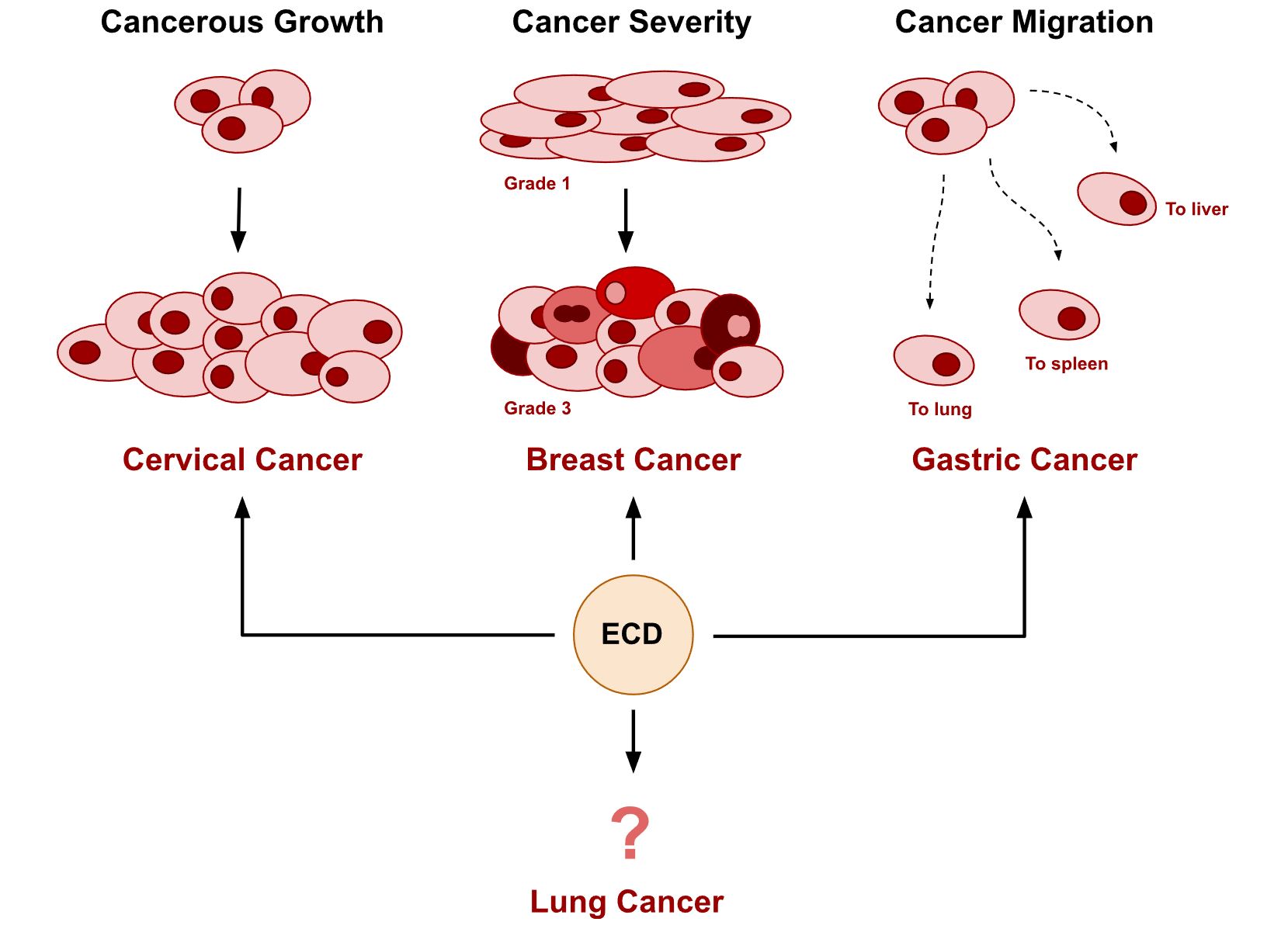
Conclusion
ECD is a gene that drives many processes central to cancer, including growth, proliferation, and metastasis. It has already been identified as an important marker for breast, cervical, and gastric cancers, but recent analyses suggest a link between ECD and lung cancer. Similar to trends in other cancers, high ECD expression correlates to poorer survival rates in lung adenocarcinoma (ADC). As we continue exploring the molecular signatures defining lung cancer, ECD is another promising marker for life-changing ADC therapeutics and diagnostic tools.
If you have any questions, comments, or insights, we would love to hear them! Feel free to share your thoughts in the project forum.
Thank you for continuing to support the World Community Grid, and empowering our research!
MCM Team